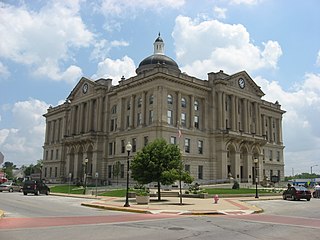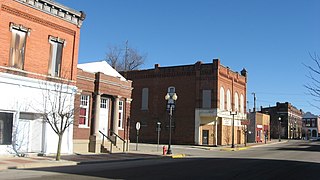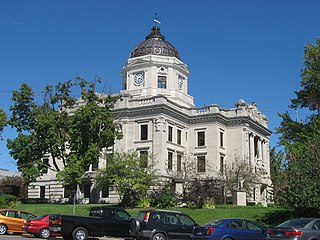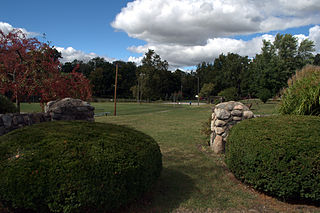
The Elwood Downtown Historic District is a national historic district located at Elwood, Madison County, Indiana. The district encompasses 51 contributing buildings and 1 contributing object in the central business district of Elwood. It developed between about 1887 and 1952, and includes notable examples of Late Victorian, Romanesque Revival, Neoclassical, and Art Deco style architecture. Notable buildings include the Calloway Block, Dehority Block (1894), St. Joseph Catholic Church (1899), United Methodist Church (1899), U.S. Post Office (1911), Carnegie Library (1901), former Elwood City Hall (1899), the Leeson's Building, and the Opera House.

Columbus Historic District is a national historic district located at Columbus, Bartholomew County, Indiana. It encompasses 574 contributing buildings and 1 contributing sites in the central business district and surrounding residential areas of Columbus. It was developed between about 1850 and 1930, and includes notable examples of Federal and Italianate style architecture. A number of commercial buildings feature locally manufactured cast iron and pressed metal components. Located in the district are the separately listed Bartholomew County Courthouse, Columbus City Hall, and First Christian Church. Other notable buildings include the First National Bank, The Crump Theatre (1889), Reo Theater, Ulrich Bakery, Samuel Harris House (1853), Keller House (1860), Old Post Office (1910), Franklin Building, Gent Mill, First United Presbyterian Church (1871-1885), Irwin Block, Irwin Home and Gardens, and St. Batholomew's Roman Catholic Church (1891).

Washington Commercial Historic District is a national historic district located at Washington, Daviess County, Indiana. The district encompasses 88 contributing buildings and 1 contributing object in the central business district of Washington. The district developed between about 1815 and 1940, and includes notable examples of Italianate, Federal, and Classical Revival style architecture. Located in the district is the separately listed Daviess County Courthouse. Other notable buildings include the City Hall (1916), Temple Court (1894), Peoples National Bank (1928), Masonic Building, Indiana Theater, American Steam Laundry Building, Baltimore and Ohio Passenger Depot (1906), Westminster Presbyterian Church (1911), and U.S. Post Office (1916).

Sheridan Downtown Commercial Historic District is a national historic district located at Sheridan, Hamilton County, Indiana. It encompasses 38 contributing buildings and 1 contributing structure in the central business district of Sheridan. It developed between about 1880 and 1939, and includes notable examples of Italianate and Romanesque Revival style architecture. Notable buildings include the H.J. Thistlethwaite Building (1886), Carnegie library, First Christian Church (1910-1911), Higbee Buggy Company, American State Bank (1914), Stanley Brothers Building, Slliot's Drugstore, Indiana Telephone Company building, and U.S. Post Office (1939-1940).

Danville Main Street Historic District is a national historic district located at Danville, Hendricks County, Indiana. The district encompasses 42 contributing buildings and 2 contributing structures in the central business district of Danville. The district developed between about 1865 and 1960 and includes notable examples of Italianate, Classical Revival, Beaux-Arts, and Tudor Revival style architecture. Located in the district is the separately liste Hendricks County Jail and Sheriff's Residence. Other notable buildings include the Hall Block, Danville Public Library (1902-1903), Hendricks County Courthouse (1915), and Danville Post Office (1936).

Huntington Courthouse Square Historic District is a national historic district located at Huntington, Huntington County, Indiana. The district includes 102 contributing buildings and 3 contributing structures in the central business district of Huntington. It developed between about 1845 and 1942 and includes notable examples of Italianate, Queen Anne style architecture in the United States, Romanesque Revival, Neoclassical, and Commercial style architecture. Located in the district are the separately listed Moore/Carlew Building and Hotel LaFontaine. Other notable buildings include the Hotel Huntington (1848), Opera House (1881), Lewis Block, Huntington County Courthouse (1904), old Post Office (1916), Citizens' State Bank, City Hall / Fire Station (1904), Huntington Light and Fuel Building, Our Sunday Visitor building (1926), YMCA (1929), and Huntington Theater.

Seymour Commercial Historic District is a national historic district located at Seymour, Jackson County, Indiana. It encompasses 79 contributing buildings and 4 contributing structures in the central business district of Seymour. The district developed between about 1876 and 1945, and includes notable examples of Italianate, Romanesque Revival, and Classical Revival style architecture. Located in the district is the separately listed Farmers Club. Other notable buildings include the Masonic Temple (1901), Richart Block (1900), Steinker Meat Market, Seymour National Bank, Southern Indiana Telephone and Telegraph Building (1929), Jonas Hotel, and Kidd Saloon (1887).

Redkey Historic District is a national historic district located at Redkey, Jay County, Indiana. It encompasses 25 contributing buildings in the central business district of Redkey. The district developed between about 1888 and 1935, and includes notable examples of Italianate, Romanesque Revival, and Classical Revival style architecture. Notable buildings include the City Building (1905), Appenseller's Department Store (1906), K of P Building (1911), Farmers an Merchants First National Bank Building, Masonic Lodge, IOOF Building, Brown-Ellis Block (1888), and Cultice-Mann Block (1891).

Hohman Avenue Commercial Historic District is a national historic district located at Hammond, Lake County, Indiana. The district encompasses 15 contributing buildings in the central business district of Hammond. It developed between about 1904 and 1956, and includes notable example of Romanesque Revival, Classical Revival, and Colonial Revival style architecture. Notable buildings include Knott's Apartments (1904), Emmerling Ambulance Garage (1918), Emmerling Building (1918), St. Joseph's Roman Catholic Church Complex, LaSalle Hotel, OK Building (1913), and the Hammond National Bank.

Culver Commercial Historic District is a national historic district located at Culver, Marshall County, Indiana. The district encompasses 14 contributing buildings in the central business district of Culver. It developed between about 1900 and 1935, and includes examples of Italianate, Colonial Revival, and Bungalow / American Craftsman style architecture. Notable buildings include the Osborn Block, Menser Building (1903), Carnegie Library (1916), U.S. Post Office (1935), Service STation, Knights of Pythias Marmont Lodge 231, and State Exchange Bank.

Courthouse Square Historic District is a national historic district located at Bloomington, Monroe County, Indiana. The district encompasses 57 contributing buildings in the central business district of Bloomington. It developed between about 1847 and 1936, and includes notable examples of Classical Revival, Beaux Arts and Italianate style architecture. Located in the district are the separately listed Bloomington City Hall, Monroe County Courthouse, Princess Theatre, and Wicks Building. Other notable buildings include the Federal Building, Masonic Temple, former Faulkner Hotel, Odd Fellows Building (1892), Allen Building (1907), First National Bank Building (1907), Knights of Pythias Building (1907), and Graham Hotel Building.

Rushville Commercial Historic District is a national historic district located at Rushville, Rush County, Indiana. The district encompasses 54 contributing buildings in the central business district of Rushville. The district developed between about 1847 and 1940 and includes notable examples of Greek Revival, Italianate, Romanesque Revival, Classical Revival, Collegiate Gothic, Commercial style, and Art Deco style architecture. Located in the district are the separately listed Durbin Hotel, Melodeon Hall, and Rush County Courthouse. Other notable buildings include the former Methodist Episcopal Church (1847-1850), Church of Christ / Boys' and Girls' Club (1850-1853), Beher-King Block (1883), Presbyterian Church (1892-1893), Rushville National Bank (1911), Phoenix Lodge (1913–1915), Rushville Public Library, and former Castle Theatre (1939).

Angola Commercial Historic District is a national historic district located at Angola, Steuben County, Indiana. The district encompasses 49 contributing buildings, 1 contributing site, and 2 contributing objects in the central business district of Shelbyville. It developed between about 1861 and the 1960, and includes notable examples of Italianate, Romanesque Revival, Beaux-Arts, Classical Revival, Late Gothic Revival, and Art Deco style architecture. Located in the district are the separately listed Steuben County Courthouse and Steuben County Jail. Other notable buildings include the Angola City Hall, Angola Police and Fire Department Building (1939), First Congregational United Church of Christ (1899), United Methodist Church of Angola (1889), Patterson Block (1861), Jackson Block (1870), Croxton Opera House (1892), Angola Masonic Building (1929), Armory Building (1916), and First National Bank (1923).

Hills and Dales Historic District is a national historic district located at West Lafayette, Tippecanoe County, Indiana. The district encompasses 136 contributing buildings and 1 contributing site in a predominantly residential section of Lafayette, platted in 1922-1924. It developed between about 1911 and 1951 and includes representative examples of Colonial Revival, Tudor Revival, French Renaissance, and Ranch style architecture. Notable contributing buildings include the Haniford House, Herbert Graves House,, and Marion J. Eaton House.

Liberty Courthouse Square Historic District is a national historic district located at Liberty, Union County, Indiana. The district encompasses 20 contributing buildings and 2 contributing objects in the central business district of Liberty and centered on the separately listed Union County Courthouse. It developed between about 1854 and 1938 and includes representative examples of Italianate, Romanesque Revival, Neoclassical, and Art Deco style architecture. Notable contributing buildings include the O'Toole Building (1936), Masonic Hall, Odd Fellows Building, Liberty Opera House, and Liberty Post Office (1937-1938).

Monon Commercial Historic District is a national historic district located at Monon, White County, Indiana. The district encompasses 24 contributing buildings in the central business district of Monon. It developed between about 1860 and 1940 and includes representative examples of Italianate and Classical Revival style architecture. Notable contributing resources include the C.M. Horner's Bank, Monon Town Hall, Carnegie Library, Howard Theater (1938), Pogue Building, Fred Thomas Building (1912), Tull Block (1921), James Tull / J. Lackerman Building, Newbold Oldsmobile Building, State Bank of Monon (1912), and Odd Fellows Building (1911).

Downtown Wabash Historic District, also known as the Wabash Marketplace District, is a national historic district located at Wabash, Wabash County, Indiana. It encompasses 27 contributing buildings in the central business district of Wabash. It developed between about 1840 and 1920, and includes representative examples of Italianate, Romanesque Revival, and Second Empire style architecture. Located in the district are the separately listed James M. Amoss Building and Solomon Wilson Building. Other notable buildings include the E.M. Conner Building (1897), Back Saddlery and Harness Shop (1845), Wabash Loan and Trust Company (1927), Bradley Block (1901), Busick Block (1882), Eagles Building (1906), the Plain Dealer Building (1897), S.J. Payne Block (1898), J.C. Penney's (1920), National Block (1876), Sheriff's House and Jail (1879), Memorial Hall (1899), U.S. Post Office (1911-1912), Wabash County Courthouse (1878), Shively Block (1897), and Wabash City Hall (1883-1884).

North Manchester Historic District is a national historic district located at North Manchester, Wabash County, Indiana. It encompasses 159 contributing buildings in the central business district and surrounding residential sections of North Manchester. It developed between about 1870 and 1938, and includes representative examples of Greek Revival, Gothic Revival, Italianate, Queen Anne, and Bungalow / American Craftsman style architecture. Located in the district are the separately listed Lentz House, Noftzger-Adams House, and North Manchester Public Library. Other notable buildings include the John Lavey House (1874), Horace Winton House, Agricultural Block (1886), Moose Lodge (1886), North Manchester City Hall, Masonic Hall (1907), Zion Lutheran Church (1882), and North Manchester Post Office (1935).

North Meridian Street Historic District is a national historic district located at Indianapolis, Indiana. It encompasses 169 contributing buildings in a high style residential section of Indianapolis. The district developed between about 1900 and 1936, and includes representative examples of Tudor Revival, Colonial Revival, and Classical Revival style architecture. Located in the district is the separately listed William N. Thompson House. Other notable contributing resources include the Evan-Blankenbaker House (1901), Sears-Townsend House (1930), MacGill-Wemmer House, Hugh Love House (1930), Hare-Tarkington House (1911), Shea House (1922), and Brant-Weinhardt House (1932).

Virginia Avenue District is a national historic district located at Indianapolis, Indiana. The district encompasses 43 contributing buildings and 1 contributing structure in the Fountain Square Commercial Areas of Indianapolis. It developed between about 1871 and 1932, and notable buildings include the Sanders (Apex) Theater (1913), Southside Wagon and Carriage Works / Saffel Chair Company, Fountain Square Theater (1928), Woessner Building, Granada Theater (1928), Southside Theater (1911), Schreiber Block (1895), Fountain Square State Bank (1922), and Fountain Bank (1902).



























